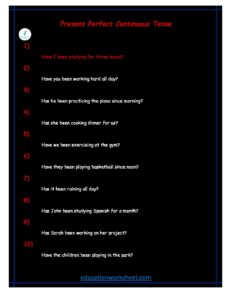how to converting Present Continuous Tense positive sentences to interrogative form
how to converting Present Continuous Tense positive sentences to interrogative form
Table of Contents
- Understanding Present Continuous Tense
- 1.1 Definition and Usage
- 1.2 Structure of Present Continuous Tense
- Converting Positive Sentences to Interrogative Form
- 2.1 Basic Rule
- 2.2 Wh-Questions
- 2.3 Yes/No Questions
- Examples
- 3.1 Affirmative to Interrogative Transformation
- 3.2 Practice Exercises
- Common Mistakes and Pitfalls
- 4.1 Verb Forms
- 4.2 Verb “to be”
- 4.3 Punctuation
- Advanced Usage
- 5.1 Information Questions
- 5.2 Embedded Questions
- Conclusion
1. Understanding Present Continuous Tense
1.1 Definition and Usage
The present continuous tense, also known as the present progressive tense, is used to describe actions or events that are happening at the moment of speaking or around the present time. It emphasizes the ongoing nature of an action. For example:
- Affirmative: “I am writing an essay.”
- Negative: “She is not watching TV right now.”
- Interrogative (question): “Are you studying for the exam?”
1.2 Structure of Present Continuous Tense

The present continuous tense is formed using the auxiliary verb “to be” (am, is, are) and the present participle (base form + -ing) of the main verb. The structure is as follows:
- Affirmative: Subject + (am/is/are) + verb + -ing
- Negative: Subject + (am/is/are) + not + verb + -ing
- Interrogative: (Am/Is/Are) + subject + verb + -ing?
how to converting Present Continuous Tense positive sentences to interrogative form
2. Converting Positive Sentences to Interrogative Form
Converting present continuous tense positive sentences into interrogative form is relatively straightforward. Let’s explore the basic rules and various types of interrogative questions.
how to converting Present Continuous Tense positive sentences to interrogative form
2.1 Basic Rule
To convert an affirmative present continuous sentence into an interrogative one, we simply change the word order. The auxiliary verb “to be” (am, is, are) is moved to the beginning of the sentence, followed by the subject, and then the main verb in its present participle form (-ing). The question is usually formed by using a question mark at the end. For example:
- Affirmative: “She is eating lunch.”
- Interrogative: “Is she eating lunch?”
2.2 Wh-Questions
Wh-questions are used to ask for specific information and typically begin with question words like who, what, where, when, why, and how. When converting present continuous tense affirmative sentences to wh-questions, we use the same word order as with yes/no questions but include the question word at the beginning of the sentence. For example:
- Affirmative: “They are playing football.”
- Wh-Question: “What are they playing?”
how to converting Present Continuous Tense positive sentences to interrogative form
2.3 Yes/No Questions
Yes/no questions are used to seek confirmation or denial of a fact and are answered with “yes” or “no.” To create yes/no questions from positive present continuous sentences, follow the basic rule of changing the word order and using the appropriate auxiliary verb (am, is, are) for the subject. For example:
- Affirmative: “You are studying English.”
- Yes/No Question: “Are you studying English?”
how to converting Present Continuous Tense positive sentences to interrogative form Want to learn how to convert Present Continuous Tense positive sentences into engaging interrogative form? Our step-by-step tutorial makes it a breeze to grasp this essential English grammar concept. Elevate your language skills and create dynamic conversations with ease. Begin your journey to fluent communication today
3. Examples
3.1 Affirmative to Interrogative Transformation
Let’s go through a series of examples to illustrate how to convert present continuous tense positive sentences into interrogative questions:
- Affirmative: “She is watching a movie.”
- Interrogative: “Is she watching a movie?”
- Affirmative: “I am cooking dinner.”
- Interrogative: “Am I cooking dinner?”
- Affirmative: “They are playing tennis.”
- Interrogative: “Are they playing tennis?”
- Affirmative: “He is not reading a book.”
- Interrogative: “Is he not reading a book?”
- Affirmative: “We are studying for the test.”
- Interrogative: “Are we studying for the test?”
3.2 Practice Exercises
To reinforce your understanding, try converting the following affirmative sentences into interrogative questions:
- Affirmative: “The dog is barking loudly.”
- Affirmative: “She is not wearing her glasses.”
- Affirmative: “They are building a sandcastle.”
- Affirmative: “I am not drinking coffee.”
- Affirmative: “We are waiting for the bus.”

4. Common Mistakes and Pitfalls
When converting positive sentences to interrogative questions in the present continuous tense, there are a few common mistakes to watch out for:
4.1 Verb Forms
Ensure that the main verb is in its present participle form (-ing) in the interrogative question. For example, “He is eating pizza” should become “Is he eating pizza?” and not “Is he eat pizza?”
4.2 Verb “to be”
Choose the appropriate form of the verb “to be” (am, is, are) based on the subject. For singular subjects, use “am” (I), “is” (he, she, it), and for plural subjects, use “are” (you, we, they).
4.3 Punctuation
Don’t forget to include a question mark at the end of the interrogative sentence to indicate that it is a question. Forgetting the question mark can change the sentence’s meaning.
5. Advanced Usage
5.1 Information Questions
Present continuous tense interrogative questions can also be used to seek specific information about an action or event. For example:
- “Where are you going?” (Seeking information about the destination)
- “What are you doing this weekend?” (Seeking information about weekend plans)
5.2 Embedded Questions
Embedded questions are questions that are part of a larger sentence. When converting positive sentences with embedded questions to interrogative form, maintain the same word order for the embedded question. For example:
- Affirmative: “She asked if he was coming to the party.”
- Interrogative: “Did she ask if he was coming to the party?”
6. Conclusion
Converting present continuous tense positive sentences into interrogative form is a fundamental skill in English grammar. By following the basic rules outlined in this guide, you can confidently transform affirmative statements into questions, whether they are yes/no questions or wh-questions. Remember to pay attention to verb forms, use the correct form of the verb “to be” based on the subject, and punctuate your interrogative questions correctly with a question mark.
how to converting Present Continuous Tense positive sentences to interrogative form
With practice and a clear understanding of these concepts, you’ll be able to construct and understand present continuous tense interrogative questions with ease, enhancing your communication skills in English.

